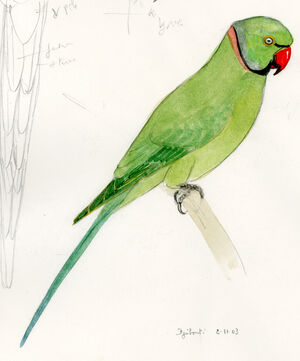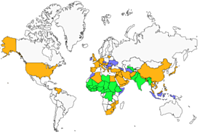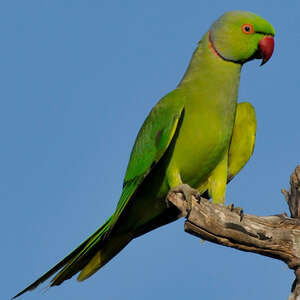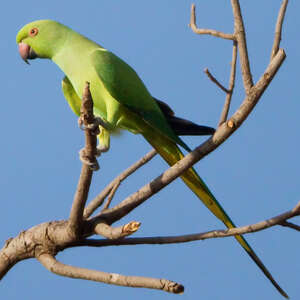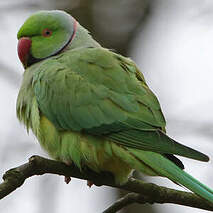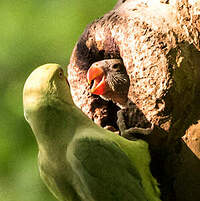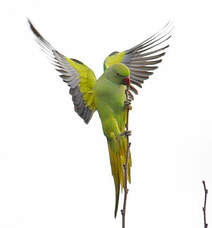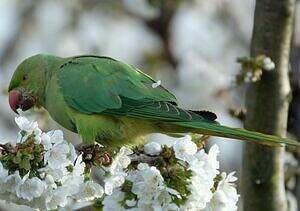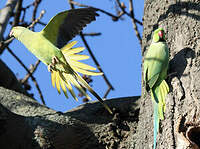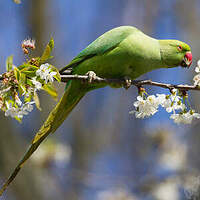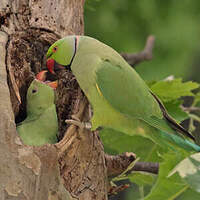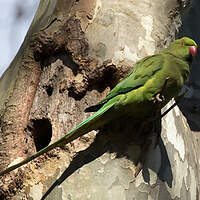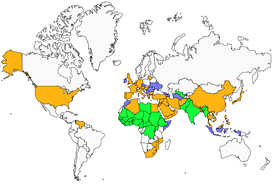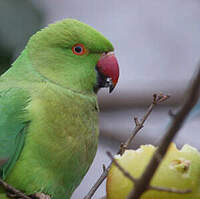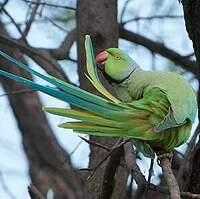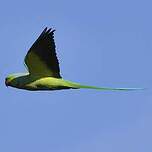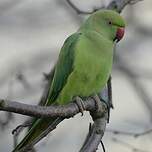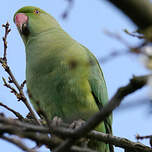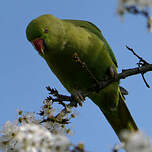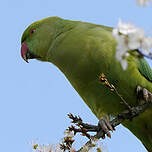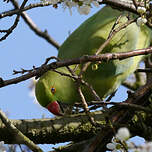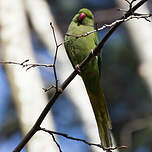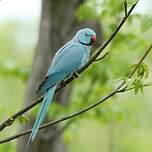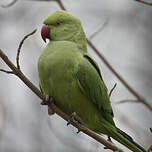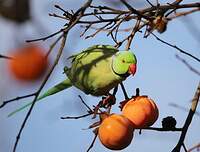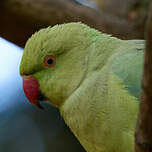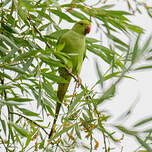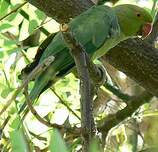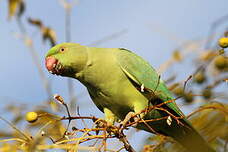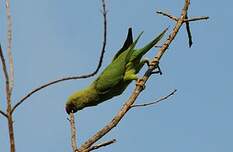Rose-ringed Parakeet
Psittacula krameri - Perruche à collier
Identification
The Rose-ringed Parakeet is a slender parakeet, about 40 cm in length, half of which is tail. It has a plumage of various shades of green and yellow on the warm parts of its body. The beak is red with a black lower mandible in the type subspecies. The eye is yellow with a red ring around it. The flight feathers are darker green on top. In bottom view, the wing shows a clear contrast between the blackish flight feathers and the green coverts. The central tail feathers are blue in the adult nuptial. There is sexual dimorphism in the head and neck. The male is distinguished from the female by its black throat extending on the sides of the neck into a thin collar edged in pink. The female lacks it. Several subspecies exist, which can only be distinguished by minor colour variations. For example, the Asian borealis subspecies has an entirely red beak whereas the type subspecies has a red and black beak.
Subspecific information 4 subspecies
- Psittacula krameri krameri (s Mauritania and Senegal to s Sudan and w Uganda)
- Psittacula krameri parvirostris (e Sudan to nw Somalia)
- Psittacula krameri borealis (nw Pakistan to se China and c Myanmar)
- Psittacula krameri manillensis (s India, Sri Lanka)
Foreign names
- Perruche à collier,
- Cotorra de Kramer,
- periquito-de-colar,
- Halsbandsittich,
- örvös papagáj,
- Halsbandparkiet,
- Parrocchetto dal collare,
- halsbandsparakit,
- Halsbåndparakitt,
- alexander malý,
- alexandr malý,
- Alexanderparakit,
- kauluskaija,
- Ringnekparkiet,
- cotorra de Kramer,
- Grænpáfi,
- aleksandretta obrożna,
- Krāmera papagailis,
- aleksander,
- Попугай Крамера,
- ホンセイインコ,
- 红领绿鹦鹉,
- 紅領綠鸚鵡,
Voice song and cries
Whether perched in a tree or in flight, Rose-ringed Parakeets emit loud cries like kii-aa or kiy-ak which are hard to miss. Other vocalisations like kyik-kyik-kyik can also be heard. In captivity, these birds are capable of imitating familiar domestic noises and even articulating a few words.
Habitat
Rose-ringed Parakeets frequent a wide variety of tree habitats, from semi-deserts to light jungles, as long as they have cavities for breeding, usually in hollow trees but not only.
Behaviour character trait
The Rose-ringed Parakeet is a gregarious, bold and opportunistic bird, capable of adapting to many situations.
It is often seen in noisy groups flying from one place to another in a very fast direct flight. Adult groups fragment during breeding which has a certain colonial character. But troops quickly reform as soon as the young have become independent. These birds are accustomed to gathering together at night in populous dormitories, presumably for protection against predators. This bird is sedentary which does not stop it from making local movements, particularly in Africa where it slightly moves north in the direction of Burkina Faso and Mauritania during the rainy season (August to November). The feral populations in Europe are perfectly sedentary and do not seem to suffer from the harsh winter climates. They have in any case at their disposal the abundant food supplied to winter feeders by individuals or institutions. The Rose-ringed Parakeet, like all psittacids, is an acrobat in trees, capable of hanging from branches with its very clawed feet. The large curved beak is an efficient tool which it uses to progress in the trees, enlarge a hole for nesting, and of course to feed itself, crack hard seeds, pick fruit, cut buds which it is very fond of, etc.Flight
Dietfeeding habits
The Rose-ringed Parakeet is almost exclusively vegetarian. Its diet consists of all sorts of fruits, various seeds, buds, flowers and other fleshy leaves, etc. In Asia, and more particularly in India, this bird is considered a real plague for agriculture as it feeds in large numbers in fields and fruit trees. In the urban parks of European cities it inhabits, its impact on ornamental or aesthetic trees and shrubs should be considered and measured to know if it is really harmful.
Reproduction nesting
In the west of Africa and likely also in the Arabian Peninsula where it has probably been introduced, the Rose-ringed Parakeet nests between December and May.
In South Africa, breeding takes place in September in willow woodlands. In Asia, reproduction occurs from January to April and sometimes in July. In the UK, the wild population breeds from January to June. Rose-ringed Parakeets nest in loose colonies. The nest is located in a tree cavity which is often enlarged or reworked by the birds themselves. It is situated between 3 and 10 meters above the ground. Sometimes, it is located in rocky terrain, inserted in a fractured rocky face or in an old wall. The clutch usually consists of 3 or 4 eggs which are incubated for 22 or 23 days. The stay of the chicks in the nest is about 7 weeks. In Nigeria, reproduction often fails due to Red-billed Hornbills (Tockus erythrorhynchus) which are aggressive and probably covet the same cavities.Geographic range
Rose-ringed Parakeet is naturally distributed in the tropical areas of the Old World. In Africa, its distribution area extends from Mauritania and Senegal to the Red Sea in a rather large sub-Saharan belt. In Asia, it mainly occupies the Indian subcontinent, but its area extends to the west of Pakistan, the south of China and Burma to the east. There are officially 4 subspecies: P. k. krameri (Africa, from southern Mauritania and Senegal to Uganda and south Sudan) - P. k. parvirostris (Africa, central-east Sudan to Djibouti and northwest Somalia, passing through Eritrea and Ethiopia) - P. k. borealis (Asia, northwest Pakistan, north India, Nepal, north Myanmar and southeast China (Guangdong)) - P. k. manillensis (Asia, Indian subcontinent south of the 20th degree of North Latitude and Sri Lanka). Many feral populations, from captivity or introduced, are now present everywhere in the world, in Africa, Arabia, Europe, Western Asia as well as in Mauritius, Hong Kong, Macao, Singapore, and even in the United States.
Threats - protection
IUCN conservation status
concern
in the Wild
threatened
evaluated
This species is not threatened. In its natural habitat and in the majority of regions where it has been introduced, it is even relatively abundant. Its adaptability to humans and their activities is at the origin of its demographic and spatial increase. This bird has a locally bad reputation due to the damage it causes, including in areas where it has been introduced. On the other hand, in an urban context, it has a rather good image, despite its discordant cries. It is beautiful to see and almost comes to eat the food provided to the birds in your hand.
Sources of information
- IOC World Bird List (v14.1), Gill, F and D Donsker (Eds). 2023.
- Handbook of the birds of India and Pakistan Vol 7, Salim ali et Dillon Ripley
- Avibase, Lepage Denis
- Vol. 12 - Handbook of the Birds of the World, Josep del Hoyo-Andrew Elliott-David Christie
- Parrots, Tony Juniper
- Parrots of the World, Joseph M. Forshaw
- Wikipédia, Wikipedia, The Free Encyclopedia
Other sources of interest
 Specification sheet created on
14/07/2023 by Jean François
Specification sheet created on
14/07/2023 by Jean FrançoisTranslation by AI Oiseaux.net
published: 09-04-2017 - Updated: 15-04-2017
© 1996-2024 Oiseaux.net
- Accipitriformes
- Aegotheliformes
- Anseriformes
- Apodiformes
- Apterygiformes
- Bucerotiformes
- Caprimulgiformes
- Cariamiformes
- Casuariiformes
- Charadriiformes
- Ciconiiformes
- Coliiformes
- Columbiformes
- Coraciiformes
- Cuculiformes
- Eurypygiformes
- Falconiformes
- Galliformes
- Gaviiformes
- Gruiformes
- Leptosomiformes
- Mesitornithiformes
- Musophagiformes
- Nyctibiiformes
- Opisthocomiformes
- Otidiformes
- Passeriformes
- Pelecaniformes
- Phaethontiformes
- Phoenicopteriformes
- Piciformes
- Podargiformes
- Podicipediformes
- Procellariiformes
- Psittaciformes
- Pterocliformes
- Rheiformes
- Sphenisciformes
- Steatornithiformes
- Strigiformes
- Struthioniformes
- Suliformes
- Tinamiformes
- Trogoniformes

